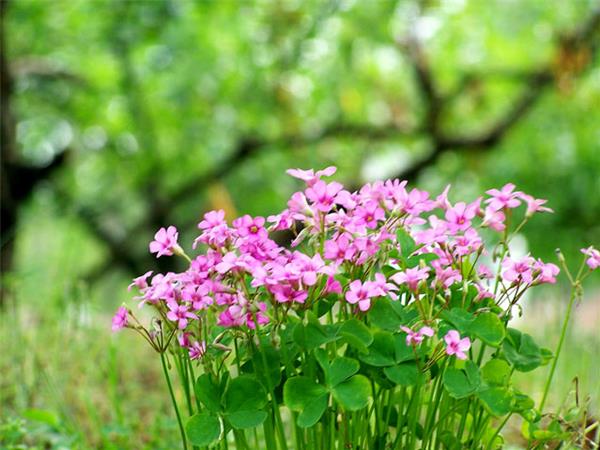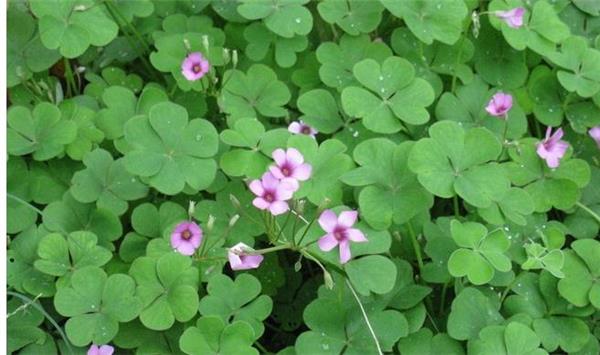How to grow safflower sorrel how to cultivate safflower sorrel
Safflower sorrel is one of the rich species of sorrel, and its leaves are often picked and given away. It is said that if you find a four-leaf sorrel leaf, it can bring happiness, so it is a very lovely plant and easy to raise.

1. Morphological characteristics of Oxalis safflower.
Perennial evergreen herb. Underground with spindle-shaped tuberous rhizomes. The plants are tufted, 20-30 cm high. Leaves long-stalked, basal, trifoliolate, leaflets sessile, inverted heart-shaped, top sunken, both sides hairy, leaf margin with yellow spots. It blossoms from April to November, in which April to July and September to November are full bloom, and there are few flowers in August. The flower stem is drawn from the base, and the flower is light red or deep pink.
2. Growth habits of Carthamus tinctorius
In the sunny, warm and humid environment, the hot areas in summer should be shaded, drought-resistant and not cold-resistant. North China needs to be cultivated in a greenhouse in winter. To the south of the Yangtze River, it can stand in the open field, like the overcast and wet environment, and has strong adaptability to the soil. The general garden soil can grow, but the sandy loam rich in humus grows vigorously and has a short-term dormancy in summer. It is easy to open up when the sun is very good.

3. Cultivation techniques of Oxalis safflower
[sowing]: safflower sorrel can also grow in general soil, but it grows fastest in fertile, loose and well-drained sandy soil. Planting should not be too deep. Apply organic fertilizer once a month during the growing period and water it in time. During the growing period, you should pay attention to watering, keep it moist, and apply fertilizer 2-3 times to keep the flowers blooming and leaves luxuriant. The growth is slow in the hot season, basically in the dormant state, should pay attention to stop fertilizing water, put in the shade, protect the summer. Fertilizer and water management should be strengthened during the peak growth period in winter and spring.
[seedling]: dig up the whole aging seedling with a shovel, gently pat off the persistent soil around the root system, and store it centrally. Dig seedlings a little further away from the plant, so as to avoid accidental injury to the bulb, and pay attention to the spade to dig straight down, not obliquely dig down, hurt the bulb.
[ramet]: the withered and residual leaves were removed and the old leaves were removed to reduce transpiration and water loss after planting. The lower old bulb should be cut off with a sharp knife, and the incision should be under the first or second new bulb, so that the seedlings with one or two new bulbs can not only remove the lower old bulb, renew and rejuvenate, but also ensure that the new plant has enough nutrients to sprout and blossom quickly. Finally, in the cut new bulb wound, dip it with fresh plant ash to prevent the wound from rotting.
[fertilization]: apply organic fertilizer in the flower bed where the aging seedlings are dug up, turn it over again and rake away the withered leaves and weeds. Generally, 0.5 to 0.8 kg / m2 of cooked cake fertilizer is applied, and appropriate phosphorus and potassium fertilizer is applied to ensure the flowering needs of safflower sorrel.
[planting]: separate the large plants of safflower sorrel, each small plant with several bulbs, and finally plant and water it. The underground stem of safflower sorrel spreads rapidly, the ramet is very easy, and can be carried out all the year round. Even in the peak flowering period, a very high survival rate can still be obtained as long as the soil at the root is pressed when planting and enough water is watered.
[pest control]: Carthamus tinctorius is easy to be damaged by red spiders. if it is not controlled in time, it can cause yellow leaves, dry up, few flowers and affect the ornamental value. Therefore, the grass can be sprayed with 1000 to 1500 times of omethoate, 0.2 to 0.3 degrees of stone sulfur mixture, and acaricides.

Fourth, the ornamental value of safflower sorrel
1. Widely planted in the garden, it can be arranged in flower beds and flower borders, and it is also a good material for potted plants.
two。 Oxalis safflower has many advantages, such as low plant, neat, leafy flowers, and can inhibit the growth of weeds. It is very suitable for planting in flower beds, flower diameter, sparse woodland and forest edge. Carthamus tinctorius can also be used for potted plants to decorate squares and indoor balconies, and it is also a good material for garden greening.
3. Oxalis safflower has a long flowering period and colorful flowers, its underground stem spreads rapidly, it can cover the ground quickly, and it is easy to cultivate and extensive management. it is suitable for large area planting as ground cover plant and open land cluster planting.

Carthamus tinctorius is a common wild plant, and its plants are generally very short, the flowers are also small and exquisite, very lovely. If potted flowers are cultivated, it can also be used to cover the surface of the flowerpot to maintain soil moisture, and its own flower shape is very charming, so growing with potted flowers can also set off a feeling of flowers competing for beauty.
And its own flower shape is very charming, so planting with potted flowers can also set off a feeling of a hundred flowers competing for beauty.
- Prev

The Culture method of Douban Green how can Douban Green not raise rotten roots
The Culture method of Douban Green how can Douban Green not raise rotten roots
- Next

[how to keep plain sailing in water] Water keeps smooth sailing, okay?
[how to keep plain sailing in water] Water keeps smooth sailing, okay?
Related
- Wuhan Hospital Iron Tree Blooming Result Was Instantly Frightened by the Gardener Master
- Which variety of camellia is the most fragrant and best? Which one do you like best?
- What is the small blue coat, the breeding methods and matters needing attention of the succulent plant
- Dormancy time and maintenance management of succulent plants during dormancy
- Minas succulent how to raise, Minas succulent plant pictures
- What are the varieties of winter succulent plants
- How to raise succulent plants in twelve rolls? let's take a look at some experience of breeding twelve rolls.
- Attention should be paid to water control for succulent plants during dormant period (winter and summer)
- Watering experience of twelve rolls of succulent plants
- Techniques for fertilizing succulent plants. An article will let you know how to fertilize succulent plants.

